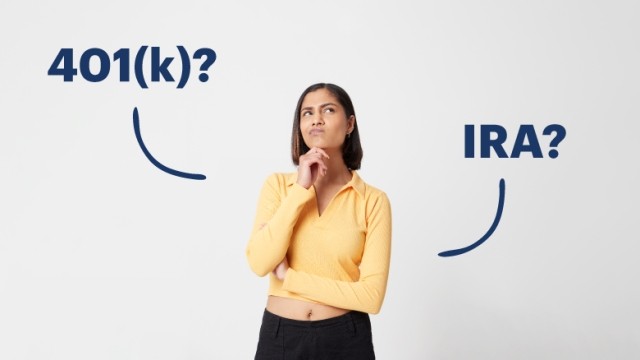IRA vs. 401(k) – What’s the difference?
Money may not buy happiness, but it does empower you to make choices.
The more options you have for finding meaning in your life and pursuing activities that excite you, the happier you’ll be. That’s what financial wellness is all about.
When it comes to retirement, you’ve got plenty of options to choose from. Some people invest in rental properties. Some figure out how to monetize their hobbies. Most people, however, chose between two basic types of retirement plans: an individual retirement account (IRA) or a 401(k).
So, how do you figure out which option is right for you?
Both leverage the power of compound interest to grow your money in a tax-deferred account, but there are some key differences between them. The main difference is that employers offer 401(k)s as part of their benefits package, while individuals open IRAs to save for retirement on their own. And although IRAs usually offer more investment options, 401(k)s allow higher annual contributions.
Here’s what you need to know to choose the retirement savings option that’s right for you.
401(k)s: Employer-sponsored retirement plans
Employers don’t always offer a retirement plan option, but when they do, it’s usually a 401(k).
While contribution limits change from year to year, a 401(k) has a significantly higher ceiling for how much you can put toward your retirement. In 2025, you can contribute up to $23,500 a year — with catch-up contributions if you're age 50 and over.
Your employer may even offer matching contributions to help you grow your retirement savings faster. For example, some employers will match 100% of your contributions up to 3% of your salary.
That’s basically free money, so it’s a good idea to try to put in at least as much as your employer will match.
IRAs: Retirement plans for everyone
What if your employer doesn’t offer a retirement plan?
In that case, an IRA is your best option. Anyone with earned income can open and contribute to an IRA, including those who already have a retirement plan through their employer. However, the annual contribution limit is much lower at $7,000 in 2024 — or $8,000 if you’re 50 or older.
You can also choose between a traditional IRA, which you can use to lower your taxable income now, or a Roth IRA, which offers no immediate tax benefit but allows you to make tax-free withdrawals during your retirement.
Do you have to choose one or the other?
Not at all! In fact, if you have enough money to contribute to both, it’s highly recommended. Having both an IRA and a 401(k) allows you to save much more each year toward your retirement. Plus, if you change jobs and need to roll over your 401(k), you’ll already have a place to put those funds.
If your employer offers matching contributions: Contribute enough to your 401(k) to earn the full match amount. Then contribute as much to your IRA as you’re allowed. Once you’ve maxed out your IRA, you can put any additional funds into your 401(k).
If your employer doesn’t offer matching contributions: Consider focusing on your your IRA first. Then contribute any additional funds to your workplace 401(k).
With both an IRA and a 401(k) at the ready, you’ll be on your way to a well-funded retirement. And more retirement income means you’ll have more options to choose from in the future.
At OCCU, we offer a number of retirement planning options, including IRAs. Our expert team can help you determine which type of investment makes the most sense for you.
Note: The above information is not intended as tax advice. Please consult your tax professional for tax information.


